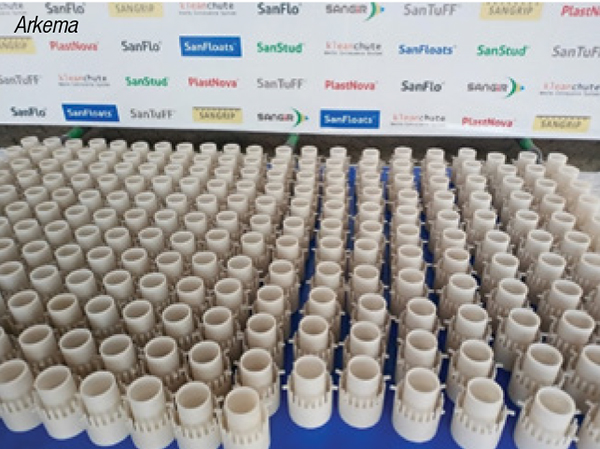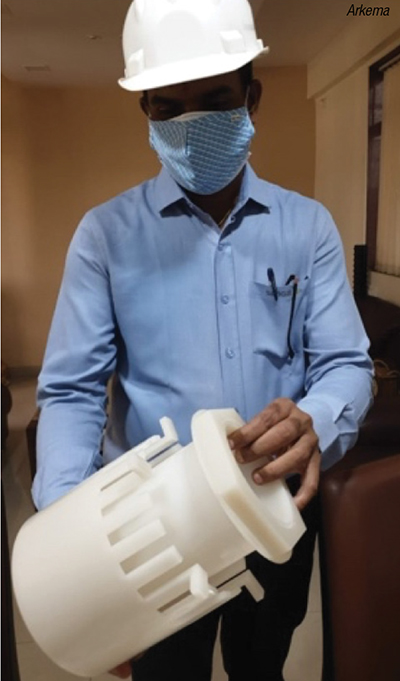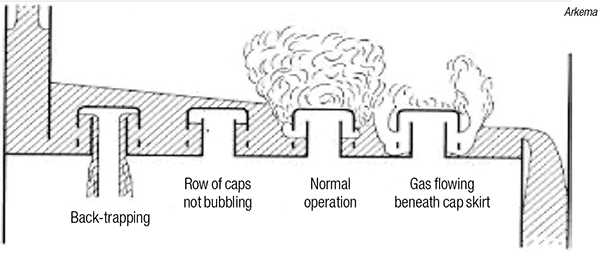Polymer components in column trays can avoid issues associated with corrosion of metal equipment
Gujarat Alkalies & Chemicals Ltd. (GACL) — a major chemical producer in Gujarat state in western India — was facing corrosion challenges with its distillation columns. In chemical processing applications, distillation columns are often used to separate and recover solvents and acids. Though these chemicals vary, many of the distillation systems experience corrosion issues if not designed properly for long-term applications. These columns typically utilize metallic components, but the harsh acidic conditions required for this application were not suitable for metals. And while metals can handle high temperatures and have good physical strength, they can be sensitive to rapid attack from acidic conditions and rapid acid concentration changes. In cases where strong acids are present, and when acid concentrations can change within the system, polymer components can be a viable option to prevent corrosion and avoid rusting. This case study describes a project where metal bubble caps in distillation column trays were replaced with bubble caps made from polyvinylidene fluoride (PVDF) resin (Figure 1) in an effort to address corrosion issues with the metal caps in a phosphoric acid plant.

FIGURE 1. Distillation tray bubble caps made from polyvinylidene fluoride (PVDF) resin can be a viable option in cases where metallic components are subject to acid attack
PVDF versus metal
The major purpose of the distillation column is to separate, recover and remove volatile organic compounds (VOCs), solvents and other lighter-than-water substances, which may be present in the flow. For many years, distillation columns have used SS-304 and SS-316 stainless-steel bubble caps, but stainless-steel bubble caps corrode in the presence of some chemicals, such as amines, chlorides and ketones, because the heat-affected zones tend to suffer amine-stress-corrosion cracking or chloride-stress-corrosion cracking, even at lower temperatures. Additionally, stainless-steel bubble caps are more bulky (in weight). Because of this, the distillation column needs to be over-designed and capital costs are high. Another option to avoid corrosion is to use fiber-reinforced polymer (FRP) bubble caps. These are an inexpensive solution, but they need to be frequently replaced due to delamination, which leads to embrittlement and failure.
The decision to switch from a metallic construction to PVDF was driven by the use of phosphoric acid in the plants. Previous distillation systems using metal components had experienced corrosion, and resolving the issue became essential for GACL to keep the plant running. When GACL sought to resolve corrosion-related issues in the distillation columns of their food-grade phosphoric acid plant, project consultant Worley India recommended they replace conventional metal bubble caps in column trays with bubble caps made from Kynar PVDF. Sangir Plastics Pvt. Ltd. is one of the major users of Kynar PVDF raw material, and is also a leading producer of customized thermoplastic products. They were able to successfully manufacture bubble caps using Kynar PVDF resins. The fabricator to which the products were supplied was Dolf Industries Pvt. Ltd. Vadodara Gujarat.

FIGURE 2. PVDF components can withstand a wide range of pH conditions
Kynar PVDF is known to have resistance to a wide range of solvents and acids. Kynar PVDF homopolymers are known to withstand pH values of <1 to 12 while Kynar Flex PVDF copolymers handle a wider pH range, from <<1 to 13.5. Operating parameters dictate the use of engineered thermoplastics, such as PVDF, and based on the service conditions and the chemicals characteristics, Kynar PVDF was selected for this project as the most suitable and compatible material of construction. GACL acheived cost savings due to the lighter weight of the PVDF materials, and also was able to optimize the critical process conditions by using lower temperatures and pressures.
Producing PVDF bubble caps
The Kynar PVDF bubble caps were manufactured from Kynar raw material supplied by Arkema. The manufacturing process involved extrusion, injection molding and fabrication. The manufacturing process also involved a high-degree of precision, exactness, finish and working within very close dimensional tolerances. Distillation columns require such precision to uniformly dissolve fumes and liquids. Not only did Arkema provide expertise in manufacturing the Kynar PVDF bubble cap, but they also met such stringent requirements and gave extensive recommendations on the fabrication processes to ensure the caps met the high level of quality requirements for the project. This project was the first time that such a product has been manufactured and supplied by injection molding, fabrication, and butt fusion to produce a highly sophisticated product. A large number of bubble caps were supplied successfully under stringent quality control conditions.
High-value polymers are lightweight and can be easily fabricated with cutting tools and heat welding. This eases both the process and costs of installation.
PVDF in the column
The Kynar PVDF bubble caps are part of bubble-cap-tray assemblies (Figure 3) used in a distillation column for low-temperature and low-pressure (P/T) applications. In bubble cap trays, vapor flowing up through the tower contacts the liquid by passing through the bubble caps. Each bubble-cap assembly consists of a riser and a cap. The vapor rising through the column passes up through the riser in the tray floor and then is turned downward to bubble into the liquid surrounding the cap. Due to their design, bubble cap trays cannot weep or leak distilled liquid. This design is suitable for yield in lower-pressure and lower-temperature conditions. However, the bubble cap needs to be designed and manufactured with extreme care to ensure that each bubble cap operates at the same efficiency factor. Thus, bubble caps are required to be exactly identical, with the same dimensional tolerances.

FIGURE 3. In bubble cap trays, vapor rising through the column is turned downward to bubble through the liquid surrounding the cap
Kynar PVDF bubble caps are used in distillation columns operating at low pressures and temperatures, as they are a good alternative to stainless-steel or FRP bubble caps. PVDF bubble caps offer extensive operational life because the product can withstand temperatures up to 130°C (266°F) and are inert to the majority of the solvents and catalysts found in distillation columns.
Edited by Scott Jenkins
Authors
 Sachin Upadhye is a business manager in the High Performance Polymers Unit at Arkema in India (Email: [email protected]). He holds post-graduate degrees in both chemistry and paint technology. Upadhye has 29 years of experience in industrial applications and material selection.
Sachin Upadhye is a business manager in the High Performance Polymers Unit at Arkema in India (Email: [email protected]). He holds post-graduate degrees in both chemistry and paint technology. Upadhye has 29 years of experience in industrial applications and material selection.
 Himanshu Mistry is the head of business development and marketing at Sangir Plastics in India (Email: [email protected]). He has over 20 years of engineering experience working in the industrial chemicals sector, leading many Indian multi-national engineering companies.
Himanshu Mistry is the head of business development and marketing at Sangir Plastics in India (Email: [email protected]). He has over 20 years of engineering experience working in the industrial chemicals sector, leading many Indian multi-national engineering companies.